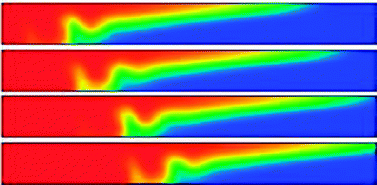Dynamics due to combined buoyancy- and Marangoni-driven convective flows around autocatalytic fronts
Abstract
A reaction–diffusion–convection (RDC) model is introduced to analyze convective dynamics around horizontally traveling fronts due to combined buoyancy- and surface tension-driven flows in vertical solution layers open to the air. This isothermal model provides a means for a comparative study of the two effects via tuning two key parameters: the solutal Rayleigh number Ra, which rules the buoyancy influence, and the solutal Marangoni number Ma governing the intensity of surface effects at the interface between the reacting solution and air. The autocatalytic front dynamics is probed by varying the relative importance of Ra and Ma and the resulting RDC patterns are quantitatively characterized through the analysis of the front mixing length and the topology of the velocity field. Steady asymptotic regimes are found when the bulk and the surface contributions to fluid motions act cooperatively i.e. when Ra and Ma have the same sign. Complex dynamics may arise when these numbers are of opposite signs and the two effects thus compete in an antagonistic configuration. Typically, spatiotemporal oscillations are observed as the control parameters are set in the region (Ra < 0, Ma > 0). Periodic behaviour develops here even in the absence of any double-diffusive interplay, which in previous literature was identified as a possible source of complexity.


 Please wait while we load your content...
Please wait while we load your content...